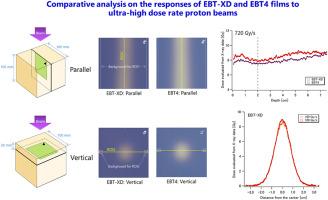Comparative analysis of the responses of EBT-XD and EBT4 films to ultra-high dose rate proton beams
IF 2.8
3区 物理与天体物理
Q3 CHEMISTRY, PHYSICAL
引用次数: 0
Abstract
Commercial radiochromic films, more specifically EBT-model Gafchromic films (EBT films), have the potential for two-dimensional profile measurements of ultra-high dose-rate (UHDR) radiation beams designed for FLASH radiotherapy. However, there is a controversy in regard to the dose-rate dependency of EBT-film responses to UHDR protons. In this study, we irradiated two types of currently available EBT films, EBT-XD and EBT4, to spread-out brag peak proton beams at 9 Gy at 180 Gy s−1 and 720 Gy s−1 in parallel and vertical beam incidences. The irradiated films were scanned with a flatbed scanner, and the inverted red color intensities were converted to absorbed doses based on the dose response curves of the red color component measured with LINAC 6 MV X-rays. The obtained dose levels were 5–15 % lower than the delivered doses, indicating the quenching effects along the tracks of high-LET charged particles. The depth dose profile obtained with the EBT-XD film at 720 Gy s−1 was notably higher than that at 180 Gy s−1, whereas such a difference was not observed with EBT4. The enhanced response of the EBT-XD film was confirmed by the sectional beam profiles obtained using vertically incident beams. These results imply that radiochromic reactions in EBT-XD film can be enhanced at the center of a Gaussian-shaped proton beam under certain UHDR conditions. Further studies are necessary to clarify the mechanism underlying the change in the responses of EBT films to UHDR protons.

EBT-XD和EBT4薄膜对超高剂量率质子束响应的比较分析
商用放射变色膜,更具体地说,EBT型Gafchromic膜(EBT膜)具有用于FLASH放射治疗的超高剂量率(UHDR)辐射束的二维轮廓测量的潜力。然而,关于ebt膜对UHDR质子反应的剂量率依赖性存在争议。在这项研究中,我们辐照了两种现有的EBT薄膜,EBT- xd和EBT- t4,在平行和垂直光束入射下,以180 Gy s - 1和720 Gy s - 1的速度展开了9 Gy的自夸峰质子束。用平板扫描仪对辐照膜进行扫描,根据LINAC 6 MV x射线测得的红色成分的剂量响应曲线,将倒转的红色强度转换为吸收剂量。得到的剂量水平比释放剂量低5 - 15%,表明高let带电粒子沿轨迹存在猝灭效应。EBT-XD膜在720 Gy s−1下获得的深度剂量谱明显高于180 Gy s−1,而EBT-XD膜在180 Gy s−1下没有这种差异。利用垂直入射光束获得的截面光束轮廓证实了EBT-XD薄膜的增强响应。这些结果表明,在一定的UHDR条件下,EBT-XD薄膜中的放射性变色反应可以在高斯型质子束的中心得到增强。需要进一步的研究来阐明EBT薄膜对UHDR质子响应变化的机制。
本文章由计算机程序翻译,如有差异,请以英文原文为准。
求助全文
约1分钟内获得全文
求助全文
来源期刊

Radiation Physics and Chemistry
化学-核科学技术
CiteScore
5.60
自引率
17.20%
发文量
574
审稿时长
12 weeks
期刊介绍:
Radiation Physics and Chemistry is a multidisciplinary journal that provides a medium for publication of substantial and original papers, reviews, and short communications which focus on research and developments involving ionizing radiation in radiation physics, radiation chemistry and radiation processing.
The journal aims to publish papers with significance to an international audience, containing substantial novelty and scientific impact. The Editors reserve the rights to reject, with or without external review, papers that do not meet these criteria. This could include papers that are very similar to previous publications, only with changed target substrates, employed materials, analyzed sites and experimental methods, report results without presenting new insights and/or hypothesis testing, or do not focus on the radiation effects.
 求助内容:
求助内容: 应助结果提醒方式:
应助结果提醒方式:


